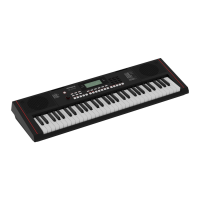10
Playing Tones
The instrument features a variety of built-in tones. Please refer to the
“Tone List” (p. 27).
Selecting a Tone
1. Press the [TONE] button to enter Tone mode.
The “TONE R1” icon on LCD lights up. The LCD displays the current
tone name and number.
2. Use the numeric buttons or [<]/[>] buttons to select a tone.
3. Play the keyboard to use the tone for performance.
Note:
When Dual and Split functions are in use, you can press the [TONE]
button repeatedly to switch between the tone layers.
Playing Two Tones Simultaneously
The dual function can layer two dierent tones together, creating a
much richer sound.
1. Press the [DUAL] button to turn on the dual function.
The “TONE R2” and “DUAL” icons on LCD light up. The LCD dis-
plays the current name and number for R2.
2. Use the numeric buttons or [<]/[>] buttons to select a tone for R2.
3. Play the keyboard. You will hear two dierent tones layered together.
It seems like two dierent instruments playing at the same time.
4. Press the [DUAL] button again to turn o the dual function.
Playing Dierent Tones with Both Hands
This function splits the keyboard into the left and the right hand are-
as, each with a dierent tone. The left hand tone is the split tone. The
default split point is F#3 (19). You can set the split point to any key as
required. Please refer to Split Point in the “Function Menu” (p. 21).
1. Press the [SPLIT] button to turn on the split function.
The “TONE L” and “SPLIT” icons on LCD light up. The LCD displays
the current split tone name and number.
2. Use the numeric buttons or [<]/[>] buttons to select a split tone.
3. Play the keyboard with both hands. You will hear two dierent tones.
4. Press the [SPLIT] button again to turn o the split function.
Notes:
1. When the keyboard is split, only the right hand area will use the dual
tones.
2. You can set the volume level for each tone layer in the mixer menu.
Please refer to “Mixer” (p. 17).

